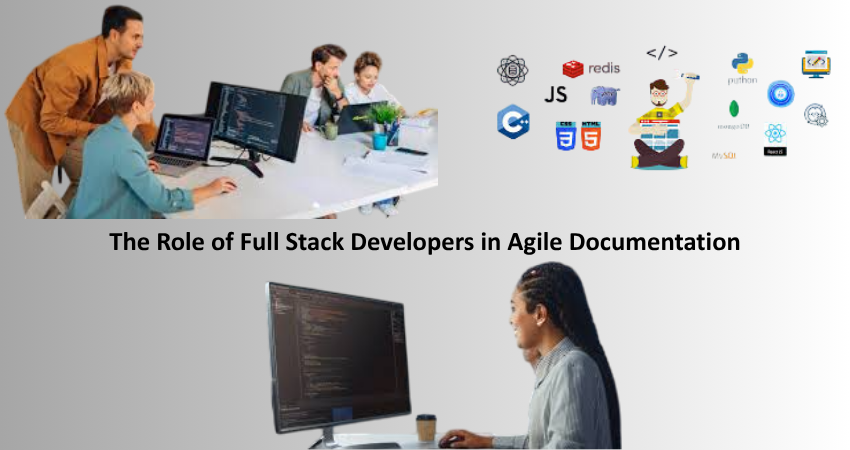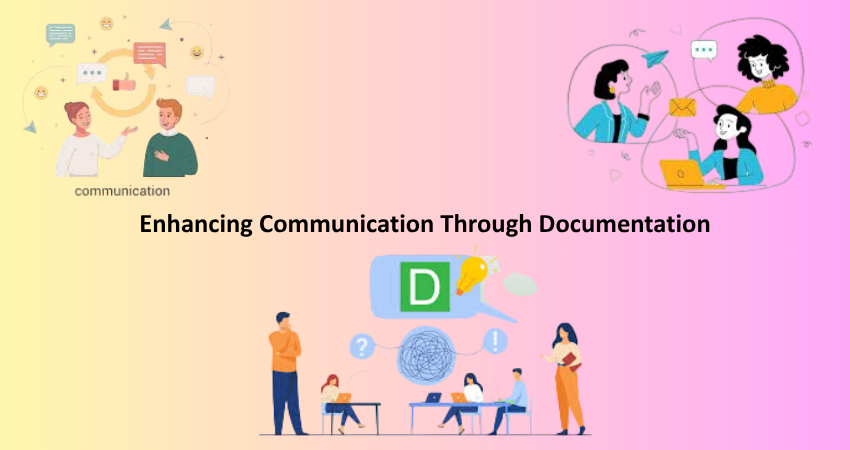
Introduction
The Agile methodologies are impacting the way software development is done by stressing adaptability, collaboration, and continuous improvement. In this fast-paced and iterative world, the role of documentation is also undergoing transformation. Long before, a time was when a documentation contract was perfect, portraying the worst so-called exhaustive form in order to predict every possible scenario up front. Today, Agile documentation is characterized by lightness, being adaptive, and having an intrinsic relationship to the development workflow. Full-stack developers are at the center of this transition, as they can perform different roles by working both in front-end and back-end development. Their all-round skill set and holistic perspective of application architecture place them in fundamental roles in the production and upkeep of qualitative Agile documentation.
This article discusses the crucial part full-stack developers play in the Agile documentation process. One can say full-stack developers enhance bridging the technical divide while improving communication and collaboration on one effective and efficient documentation. When we shall speak of the contribution of these developers regarding maintenance of technical accuracy, documentation proper, and knowledge transfer between cross-groups, we shall know how these full-stack developers intervene into Agile documentation: this knowledge further provides one insight into their productivity and clarity in the contemporary world of developing software.
Understanding Agile Documentation in Modern Development
What Is Agile Documentation?
Agile documentation involves establishing and sustaining a lightweight, flexible, interchangeable and quality project documentation. In contrast to the norm where vast libraries of text are produced in combing through opportunities of compiling huge libraries in static manuscripts, this guarantees that only the bits of information absolute for the moment within development will be pointed out so as to apply this “just in time” approach to work in an effort to reflect, once again, the principles of Agile. The main focus is working pieces of software compared to very huge documents, continuous customer feedback, and teams across distributions. It is clear that the emergence of agility brings a complete elimination of almost all unnecessary overheads but still provides meaningful guidance-on development, testing, deployment, or user coverage.
Simply put, Agile documentation encourages the minimal but adequate documentation that evolves with the product over time. In fact, it makes an agile development team so quick in action with changes because they are free with the old and too much documentation; everyone goes to understand and stay in touch with what the others are thinking, sharing, and well-informed on the same project goals. When documentation is truly owned by teams and integrated into everyday work, it can help Agile teams prepare high-quality but useful artifacts for all groups of concern. In a way, the understanding of this shift in thinking about documentation will need a completely new drive from everyone in the team, including full-stack developers.
The Importance of Documentation in Agile Teams
Documentation, even in fast-paced Agile environments, ensures continuity, prevents knowledge silos, and helps make collaboration scalable. Agile does not say that there is no documentation; instead, it means documenting the right things at the right time. Very good documentation in Agile contains user stories, acceptance criteria, API reference lists, architecture diagrams, deployment guides, etc. These are essentially living artifacts that change together with the product, not static documents that are created upfront at project initiation.
With insufficient documentation, Agile teams confront hurdles in onboarding new team members and keeping track of various feature implementations in the project and for maintaining consistency within technical decisions. Full-stack developers are in a special position to make a difference in the documentation with their well-balanced skill set: they usually understand both the front end and the back end of the systems developed. Their approach to finding solutions from across the disciplines gives them enough perspective to fill in the gaps in communication between various domains so that the documentation reflects the behavior of the system. High-quality Agile documentation enhances planning, concurrent iterations, and agile resilience in development.
Full-Stack Developers: Bridging the Gap Between Front-End and Back-End

Who Are Full-Stack Developers?
Full-stack developers are software professionals who have a wide range of competency in all the front-end and back-end technologies. From the user interface down to server-side logic, databases, and infrastructure, they have all-encompassing knowledge of how web applications work. Thus, they can build end-to-end applications or work at different layers of the software stack. As a result, full-stack developers are often multitalented, flexible, and able to work with UX designers and DevOps engineers. Full-stack developers often work in an agile team, providing great value to teams.
Additionally, these fuller skills enable a full-stack developer to characterize how a certain system interacts with each other and how changes made within one area would affect another area. This holistic approach is important in fast Iteration in Agile Development, which, as core principles, follows cross-functioning of different people and the continuous iteration of their work from the central points. The understanding of different users and the underlying technical architecture encourages the whole application’s following documentation to be accurate, relevant, and comprehensive within its life. Hence, can be connected as a connective tissue with other team members with specialized roles to have clearer conversation and reduced misalignment.
Full-stack developers are seasoned software engineers, competent in both front-end and back-end technologies. Such developers have a complete concept of how web applications get to work from user-interface down to server-side logic, databases, and infrastructure. This dual knowledge enables them to create entire applications from the configured start to finish or work effectively across various layers of the software stack. They would further create a pool of resources and are often versatile, adaptable, and capable of collaborating with both UX designers and DevOps engineers, truly enhancing the contribution of Agile teams.
The wider skill-sets gained give full-stack developers an understanding of the interaction between different areas in a system and between systems with one type of change affecting another. Such an overall view is important when developing in Agile, which takes some of its principles from rapid iteration, cross-functioning, and continuous integration of roles. If a full-stack developer has an insight into both ends of the user experience and that of the underlying technical architecture, then documentation would be rendered accurate, relevant, and comprehensive throughout the life of the application, while providing connective tissue between all team members holding specialized roles to have clearer communication and decreased misalignment.
The Strategic Advantage of Full-Stack Developers in Agile Environments
In Agile environments, whereby self-organization and adaptability to changes are recommended for teams, full-stack developers turn to be a strategic advantage to fill knowledge gaps and enhance general team productivity. Their movement between the client side and server side of application development makes them indispensable in sprint delivery cycles characterized by rapid turnaround times and continuous deployment. Besides coding, full-stack developers also perform testing, deployment, performance tuning, and documentation of features and processes.”
As such, the presence of full-stack developers fosters an environment of collaboration and knowledge sharing across Agile teams. Since they are able to contribute in different areas, full-stack developers also serve as an enabler for the consistency of documentation practices and standards. For example, a full-stack developer is able to write API documentation to reflect not only how the endpoints are consumed by the front end but also how the back end works, thus making the documentation useful to other developers, QA engineers, and, ultimately, stakeholders. Their cross-functional profile makes them ideal players in adapting and evolving documentation in an Agile environment.
Responsibilities of Full-Stack Developers in Agile Documentation
Writing and Maintaining Technical Documentation
The big pot, where full-stack developers in Agile documentation express their practice, includes writing and maintaining technical documentation. Here, we are looking at API reference, architecture diagrams, component-level details and information, deployment ways, and integration guides. Their ability to see through the model and the view makes them more capable of promoting the interaction of tracing the documentation between UI components and server-side code. Therefore, the autonomy of their comprehensive knowledge ensures that documentation practices are fulfilled in a coherent manner.
The advantages mentioned above are grounded in the full-stack developer’s involvement in practically all stages of the SDLC, gaining direct exposure in implementing and testing the features and putting them live. This gives experience in crafting documentation that is both technically sound and contextually relevant. It explains the “why” and the “how” regarding certain design decisions or approaches to implementation for full-stack developers-an important context for any future maintainer, tester, or developer. This will give insight into the understanding of particular architectural or coding choices.
Keeping Documentation Aligned with Code Changes
Timeliness in the documentation of specifications and things, something which is very necessary in agile-sharing environments with constantly changing codebases, usually has to be done by full-stack developers because the people who do end-to-end development mostly make any change in features, APIs, or workflows. As part of it, if documentation has to be updated, it can be done very swiftly. Mostly, it helps no documentation rot, where documents, over time, become irrelevant or misleading.
It is not just text that needs to be updated; it refers to ensuring that the information within it is accurate with respect to the current state of the software and how it was expected to behave. Full-stack developers can use many tools to integrate documentation generation into the development pipeline-such as Swagger for API docs, Markdown for readme files, and Sphinx for Python documentation. By including documentation updates in their Definition of Done, Agile teams ensure that working software is paired with up-to-date knowledge resources in every sprint. With a holistic perspective, Full-stack developers are in the best position to lead such initiatives.
Enhancing Communication Through Documentation

Facilitating Cross-Team Collaboration
Documentation isn’t only a technical asset-it’s also a medium through which people communicate. Documentation is especially clear in Agile teams having front-end developers, back-end engineers, UX designers, QA testers, and product managers since it aligns expectations and created mutual understanding regarding the goals and requirements of functionality. Full-stack developers understand everything in an application and, therefore, fall under perfect personages that can facilitate this type of communication with the ability to translate the technical details between specialists, clarify misunderstandings, and keep documentation updated by diversifying input.
For instance, a full-stack developer would write a documentation detailing how a certain API endpoint serves a front-end feature, together with validation rules, database interactions, and possible error messages. Such kinds of all-in documentation help front-end developers, testers, and even non-tech stakeholders understand the complete workflow. This collaboration strengthens the team cohesion, thus helping to avoid the rework that comes from miscommunication or misaligned expectations. In this manner, the documentation becomes cohesive in nature when one speaks of Agile development as well; full-stack developers are the glue holding it together.
Supporting Onboarding and Knowledge Transfer
In Agile contexts where roles may be fluid or new hires come on board rapidly, the need for effective onboarding becomes paramount. Good documentation significantly hastens the time to productivity for newcomers. Full-stack developers will contribute to the onboarding by documenting in a way that is easily accessible to both technical and semi-technical audiences the major aspects of workflows, system architecture, coding conventions, and deployment strategies. Their broad view allows them to ascertain what new team members need to know across a full stack.
Knowledge transfer is not a one-time event in Agile teams; it is a continuing process. When developers leave or shift to other projects, their respective knowledge should not walk out the door with them. Full-stack developers are key in helping retain this institutional knowledge by documenting not only what was built but also how and why it was built. This ensures that development continues uninterrupted, causes minimum disruptions, and empowers the teams to keep operational during transitions. Their documentation, therefore, is a historical account and a living guide for future development.
Conclusion: Elevating Agile Teams with Full-Stack Documentation
More than simply coders who are proficient at many tasks, full-stack developers are integral to Agile documentation. They can create good documentation because they can work on both the front-end and back end independently, thus developing perspective that enables them to write documents comprehensively and accurately while considering contexts. Full-stack developers also help ensure that further development will accompany such pace with accompanying documentation in the Agile sense where collaboration, change, and speed are everything.
As tech writers for the development team’s technical guide and updating API references, they could onboard and facilitate cross-team collaboration, thus enhancing the add-agile documentation value at all stages within the development lifecycle-from writing tech guides, updating API references, onboarding, and collaboration across teams. This involvement will reduce the knowledge gap and misunderstandings and create an atmosphere of continuous culture learning and improvement. Today, as Agile paradigms continue to evolve, the role of full-stack developers becomes ever more important in keeping up effective documentation for the success of modern development teams.